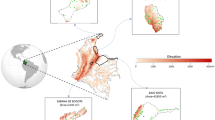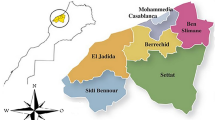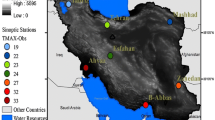Abstract
Simulation of future temperature changes is crucial in the assessment of regional impacts of climate change. This study uses the statistical downscaling Model to simulate changes in monthly maximum temperatures for the selected present period (1981–2010) and future periods (2011–2040, 2041–2070 and 2071–2099) at four weather stations in Botswana based on the Hadley Centre Couple Model Version 3 (HadCM3) output under A2 and B2 scenarios. The four weather stations are Francistown, Gantsi, Shakawe and Tshane. Their observed daily maximum temperatures (predictands) were obtained from the Botswana Department of Meteorological Services. Large scale atmospheric variables (predictors) were obtained from the data portal http://is.gd/hadcm3. More attention in the analysis is given to simulated monthly maximum temperatures and the 95th percentile of simulated monthly maximum temperatures. The simulated temperatures are assessed against observed mean monthly maximum temperatures for the selected present period. The highest temperature increase is predicted to occur in November at all the selected four stations while the lowest temperature increase is predicted to occur in January at three of the selected four stations. At two of the selected four stations, temperature increase related to A2 predictors is greater than that related to B2 predictors. This is not surprising because the A2 scenario is worse than the B2 scenario.









Similar content being viewed by others
References
Abbasnia M, Toros H (2016) Future changes in maximum temperature using the statistical downscaling model (SDSM) at selected stations of Iran. Model Earth Syst Environment 2:68–75
Antzen J (2005) Livelihoods and biodiversity in the Okavango Delta, Botswana. Center for Applied Research, Gaborone
Arguez A, Vose RS (2011) The definition of the standard WMO climate normal: the key to deriving alternative climate normals. Bull Am Meteorol Soc 92(6):699–704
Bhalotra YPR (1984) Climate of Botswana Part I: climatic controls. Department of Meteorological Services, Gaborone
Bhalotra YPR (1987) Climate of Botswana Part II: elements of climate. Department of Meteorological Services, Gaborone
Central Statistics Office (2011) 2011 Botswana population and housing census alphabetical index of villages, Census Office, Gaborone
Chu J, Xia J, Xu CY, Singh V (2010) Statistical downscaling of daily mean temperature, pan evaporation and precipitation for climate change scenarios in Haihe River, China. Theoret Appl Climatol 99(1):149–161
Gagnon S, Singh B, Rousselle J, Roy L (2005) An Application of the statistical downscaling model (SDSM) to simulate climatic data for streamflow modelling in Québec. Canadian Water Resources Association 30:297–314
Gebremeskel S, Liu YB, De Smedt F, Hoffmann L, Pfister L (2004) Analyzing the effect of climate changes on streamflow using statistically downscaled GCM scenarios. Int J River Basin Manag 2(4):271–280
Grotch S, MacCracken M (1991) The use of general circulation models to predict regional climate change. J Clim 4:286–303
Huang J, Zhang J, Zhang Z, Xu C, Wang B, Yao J (2011) Estimation of future precipitation change in the Yangtze River basin by using statistical downscaling method. Stoch Env Res Risk Assess 25(6):781–792
Kgathi DL, Mmopelwa G, Vanderpost C, Wolski P, Motsholapheko MR (2013) Impacts of desiccation on ecosystem services and household adaptation in the Okavango Delta, Botswana. Biodiver Ecol 5:263–277
Krol MS, Jaeger AK, Bronstert A (2003) Integrated modeling of climate change impacts in Northeastern Brazil. In: Global change and regional impacts. Springer, Berlin, pp 43–56
Leith NA, Chandler RE (2010) A framework for interpreting climate model outputs. J R Stat Soc: Ser C (Appl Stat) 59(2):279–296
Mahmood R, Babel MS (2014) Future changes in extreme temperature events using the statistical downscaling model (SDSM) in the trans-boundary region of the Jhelum river basin. Weather Clim Extremes 5–6:56–66
Mbaiwa J (2004) Causes and possible solutions to water resource conflicts in the Okavango River basin: the case of Angola, Namibia and Botswana. Phys Chem Earth 29:1319–1326
Moses O (2007) Study of stochastic and statistical behavior of some climatic parameters in Botswana. Dissertation, University of Botswana
Moses O (2017) Heat wave characteristics in the context of climate change over the past 50 years in Botswana. Botswana Notes Records 49:13–25
Moses O, Parida BP (2016) Statistical modelling of Botswana’s monthly maximum wind speed using a four-parameter Kappa distribution. Am J Appl Sci 6:773–778
Moses O, Ramotonto S (2018) Assessing forecasting models on prediction of the tropical cyclone Dineo and the associated rainfall over Botswana. Weather Clim Extremes 21:102–109
Moses O, Lungu E, Parida BP (2017) Transfer function-noise modeling of the dynamic relationship between Botswana’s monthly maximum temperature and evaporation. Am J Environ Sci 13(2):138–148
Murray-Hudson M, Wolski P, Ringrose S (2006) Scenarios of the impact of local and upstream changes of climate and water use on hydro-ecology in the Okavango Delta. J Hydrol 331:73–84
Nakicenovic N, Alcamo J, Grubler A, Riahi K, Roehrl RA, Rogner HH, Victor N (2000) Special report on emissions scenarios (SRES), a special report of Working Group III of the intergovernmental panel on climate change. Cambridge University Press, Cambridge
Ramberg L, Hancock P, Lindholm M, Meyer T, Ringrose S, Sliva J, Van As J, VanderPost C (2006) Species diversity of the Okavango Delta, Botswana. Aquat Sci 68:310–337
Shongwe ME, Van Oldenborgh GJ, Van Den Hurk BJJM, De Boer B, Coelho CAS, Van Aalst MK (2009) Projected changes in mean and extreme precipitation in Africa under global warming Part I: southern Africa. J Clim 22(13):3819–3837
Solomon SDQ, Manning M, Marquis M, Averyt K, Tignor MMB, Miller HL Jr, Chen Z (2007) Climate change 2007: the physical science basis. Cambridge University Press, Cambridge
Souvignet M, Gaese H, Ribbe L, Kretschmer N, Oyarzún R (2010) Statistical downscaling of precipitation and temperature in north-central Chile: an assessment of possible climate change impacts in an arid Andean watershed. Hydrol Sci J 55(1):41–57
von Storch H (1999) The global and regional climate system. In: Anthropogenic climate change. Springer, Berlin, pp 3–36
Wilby RL, Dawson CW (2004) Statistical downscaling model. User Manual
Wilby RL, Dawson CW (2007) SDSM 4.2—a decision support tool for the assessment of regional climate change impacts. User Manual
Wilby RL, Dawson CW (2013) The statistical downscaling model: insights from one decade of application. Int J Climatol 33:1707–1719
Wilby RL, Wigley TML (2000) Precipitation predictors for downscaling: observed and general circulation model relationships. Int J Climatol 20:641–661
Wilby RL, Dawson CW, Barrow EM (2002) SDSM - a decision support tool for the assessment of regional climate change impacts. Environ Model Softw 17(2):145–157
Wilby RL, Charles S, Mearns LO, Whetton P, Zorito E, Timbal B (2004) Guidelines for use of climate scenarios developed from statistical downscaling methods. IPCC Task Group on Scenarios for Climate Impact Assessment (TGCIA)
Wilby RL, Dawson CW, Murphy C, O’Connor P, Hawkins E (2014) The statistical downscaling model—decision centric (SDSM-DC): conceptual basis and applications. Clim Res 61:259–276
Wolski P (2009) Assessment of hydrological effects of climate change in the Okavango basin. EPSMO, Cape Town
Wolski P, Murray-Hudson M (2008) Alternative futures of the Okavango Delta simulated by a suite of global climate and hydro-ecological models. Water SA 34(5):605–610
Wolski P, Gumbricht T, McCarthy TS (2002) Assessing future change in the Okavango Delta: the use of a regression model of the maximum annual flood in a Monte Carlo simulation. In Conference on Environmental Monitoring of Tropical and Subtropical Wetlands, pp 4–8
Zorita E, von Storch H (1998) The Analog method as a simple statistical downscaling technique: comparison with more complicated methods. Am Meteorol Soc 12:2474–2489
Acknowledgements
The University of Botswana’s Office of Research and Development (ORD) supported this research. The Botswana Department of Meteorological Services availed daily temperature observational data and the Canadian Climate Data and Scenarios availed the daily large-scale atmospheric variables. Thanks also to Dr W. Hambira for her comments that improved the quality of the paper.
Author information
Authors and Affiliations
Corresponding author
Additional information
Publisher’s Note
Springer Nature remains neutral with regard to jurisdictional claims in published maps and institutional affiliations.
Rights and permissions
About this article
Cite this article
Moses, O., Gondwe, M. Simulation of changes in the twenty-first century maximum temperatures using the statistical downscaling model at some stations in Botswana. Model. Earth Syst. Environ. 5, 843–855 (2019). https://doi.org/10.1007/s40808-019-00571-5
Received:
Accepted:
Published:
Issue Date:
DOI: https://doi.org/10.1007/s40808-019-00571-5




